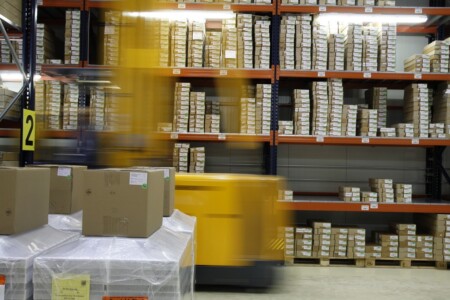Lighting in warehouses is indispensable to ensure the smooth running of operational cycles within the logistics installation. Here, not only are goods stored, but also tasks such as order preparation, inventory control and many others, which require adequate lighting.

Companies are looking for solutions that not only provide greater well-being and safety for workers, but also help to reduce their lighting bills and, as far as possible, CO2 emissions. When choosing lighting for a warehouse, energy saving is one of the variables to be taken into account.
The importance of lighting systems
Proper lighting in the warehouse means that tasks are carried out more efficiently and safely, also leading to a reduction in costs due to lower electricity consumption and fewer errors:
– Protecting the health of operators: inadequate lighting can lead to fatigue, tiredness, headaches and stress. With proper lighting, operators work in a healthier environment;
– Increased safety: a well-lit warehouse helps to significantly reduce the risk of accidents;
– Increased productivity: both lack and excess of light can make workers feel unwell. With appropriate lighting, on the other hand, operators can concentrate on their work and be more precise;
– Energy savings: with appropriate lighting, companies can significantly reduce their electricity bills.
The usefulness of LED lighting systems
Companies, in order to have proper lighting in their warehouses, must consider the following requirements:
– Dimmed light: light must be projected in a dimmed manner so as not to dazzle operators;
– Strobe effect: produced by flashing lights that cause glare. This effect should be avoided because it makes it difficult for operators to work.
– Amount of light: the lights must illuminate all the areas necessary to ensure that the operators can do their work properly.
– Shadows: when mounting the lights, it must be ensured that no shadows are produced, as they could obstruct the operators’ vision.
LED lamps are the most suitable for a logistical installation because they last longer than traditional lamps and provide greater energy savings. In addition, LED lighting is an important step towards the ecological transition.
The strengths of this technology can be summarised as follows:
– Light quality: LED technologies work at lower temperatures and have a better colour index more similar to natural light;
– Energy efficiency: systems using these technologies offer efficiency and energy savings of up to 50 per cent compared to conventional ones;
– Longevity: these systems have greater durability and almost zero maintenance. In addition, they do not suffer from dimming like conventional lighting systems, which tend to decline in intensity over the years.
The QUANTUM offering
Quantum knows how crucial it is to see what you are doing, as the basis of all process monitoring is visual inspection, which will not be effective if there is poor or inadequate lighting.
Our turnkey project is realised without introducing changes to the existing electrical wiring.
In order to transform your lighting system into a generator of savings, we intervene by replacing the existing luminaires with new digital LEDs connected to the Internet:
– We equip each luminaire with its own intelligence using technologies of our own design;
– We network it
– We control it via the Internet
– We collect its energy consumption and operating status
The system proposed by Quantum allows complete control of the lighting system via a hierarchically arranged network of interconnections (Smart Grid) that enables each individual lighting point to be remotely controlled according to predefined sensor inputs or profiles, alarms to be managed and consumption/savings to be reported.
A further step: the monitoring and control system
Checking consumption is the starting point of any energy audit.
 Our technicians, with EGE (Expert in Energy Management) and CMVP (Certified Measurement & Verification Professional) qualification, take care of energy surveys and calculations, taking a census of the plants and mapping the systems connected to the network, using ad hoc computer supports and specific measurement instruments: a real check-up of the company’s energy needs and consumption is the basis of our intervention proposals.
Our technicians, with EGE (Expert in Energy Management) and CMVP (Certified Measurement & Verification Professional) qualification, take care of energy surveys and calculations, taking a census of the plants and mapping the systems connected to the network, using ad hoc computer supports and specific measurement instruments: a real check-up of the company’s energy needs and consumption is the basis of our intervention proposals.
It is necessary to be able to read the data remotely and for this Quantum provides tools to monitor the energy trends of your utilities: the EARP (Enhancing Automated Reporting Platform) software incorporates the IPMVP (International Performance Measurement and Verification Protocol) for automatic baseline adjustment and energy pattern recognition through Artificial Intelligence that enables the prediction of ECM (Experimental Sampling Method) behaviour and Smart Alerts.
The EARP is not just an energy monitoring dashboard, but a complete turnkey solution that collects and analyses energy data and any other factors that provide correlations and predictions on system behaviour. EARP is also an analysis environment where the industry-standard IPMVP protocol is used to evaluate and track adjustments to the baseline and ensure that savings are always comparable with the current situation.
When dealing with warehouses, lighting in the storage aisles is crucial for operators to be able to find the locations in which to store goods and correctly identify the products they need to take off the shelves.
Another important detail in warehouse lighting is that not all lights have to be on all the time: Quantum offers solutions that switch certain areas off automatically during idle times.
We can therefore conclude by saying that in the modern logistics chain, lighting should not be considered a marginal element but, on the contrary, absolutely basic.